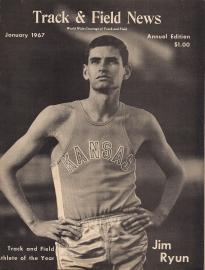 Jim Ryun, on the cover of the Bible of the Sport, Track & Field News
Jim Ryun, on the cover of the Bible of the Sport, Track & Field News
For a kid growing up in the 1960s, if you were into track and field, you knew about Jim Ryun. I finally met Mr. Ryun about thirty years later. I always admired his fortitude and love of the sport. It is amazing that his fantastic mile record is nearly fifty years old (in a couple of days). Here is Bob Burns’ fine article on Jim Ryun and the wonderful mile he ran, in Bakersfield, one half century ago.
Do yourself a favor and watch the run on YouTube, after you read Bob’s feature.
Jim Ryun’s run for the ages
Fifty years ago on June 23, 1967, Jim Ryun famously broke his own world record in the mile by .02 in Bakersfield, California. USATF and Sacramento Sports Commission take a look back at Ryun’s triumph ahead of the 2017 USATF Outdoor Championships, June 22-25, at Sacramento State University.
Contributed by Bob Burns
Jim Ryun was used to setting world records, so his 3:51.1 mile at the 1967 AAU Championships hardly came as a surprise. What surprised him was how effortless it felt.
“It was one of the easiest races of my life,” Ryun said. “In fact, I don’t ever remember running with such ease.”
On June 23, 1967, on a sweltering Friday night in Bakersfield, California, Ryun shaved two-tenths of a second off the world record he’d set 11 months earlier in Berkeley. Racing against the best milers in the United States – the top seven finishers broke four minutes – Ryun decimated the field with a 53-second last lap. Jim Grelle, the runner-up, finished 40 yards back in 3:56.1.
“I took the lead at the start with the intent of giving it away as soon as possible, but no one wanted it,” Ryun said. “As the race went on, I kept looking over my shoulder, not to taunt the other runners, but because I wondered where they were.”
Fifty years later, Ryun holds the distinction of being the last American to hold the world record in the men’s mile. With the current mark at 3:43.13 – set by Hicham El Guerrouj of Morocco in 1999 – he could retain that distinction for years to come.
Two weeks after Bakersfield, Ryun faced his arch-rival from Kenya, Kip Keino, in the U.S. vs. British Commonwealth meet in Los Angeles. The 1,500-meter showdown was taut for three laps, but Ryun’s withering kick left Keino nearly as far behind as Grelle had been in Bakersfield. Ryun shattered Herb Elliott’s seven-year-old world record of 3:35.6 by clocking 3:33.1, the metric equivalent of a 3:50.1 mile.
Later that summer, Ryun trounced the top European, Bodo Tummler, with an unprecedented 50.6-second final lap in a 1,500-meter race in Dusseldorf, West Germany. That remains one of the fastest last laps ever run in either the 1,500 or the mile.
Though he was just 20 and would go on to make two more Olympic teams, 1967 proved to the pinnacle of Ryun’s track career. The Mexico City Olympics in 1968 gave the altitude-acclimated Africans a big advantage, and Keino relegated Ryun to silver medal in the 1,500 meters. At the 1972 Olympics in Munich, Ryun was tripped in a qualifying heat and eliminated.
Ryun enjoyed a successful post-running career, representing his Kansas district in the U.S. House of Representatives from 1996 to 2007. He and his wife Anne live in Washington D.C., and he remains close to the sport through his eponymous Jim Ryun Running Camps.
From 1964 through 1972, Ryun was one of the most famous athletes in the world. Sports Illustrated named him Sportsman of the Year in 1966 and put him on the cover of its magazine seven times. He won the AAU’s Sullivan Award in 1966 and was inducted into the USATF Hall of Fame in 1980.
Ryun was the first high school runner to break four minutes in the mile, and he qualified for his first Olympic team in 1964 as a high school junior. In addition to his three world records in the mile and 1,500 meters, he was the first man to run sub-1:45 in the 800m, clocking 1:44.9 in 1966. His 3:51.1 mile remained the world record for eight years.
Yet for all his accomplishments, critics wondered if he ever reached his full potential, or if he burned himself out by training so hard as a teenager. Ryun says he’s satisfied with his career, but the 3:51.1 in Bakersfield does make him wonder how fast he might have run the mile under better conditions.
“I’ve been told a regular synthetic track is worth a second (per) lap,” Ryun said. “I don’t think about that, but the Bakersfield track was baked clay, and by the time we ran the mile in the evening it was ground up like sawdust. If you watch the video of the race, you can see that I’m almost stepping on the curve, trying to get my footing.”
Fifty years ago, it didn’t matter what surface he ran on. Jim Ryun was a miler for the ages.



















